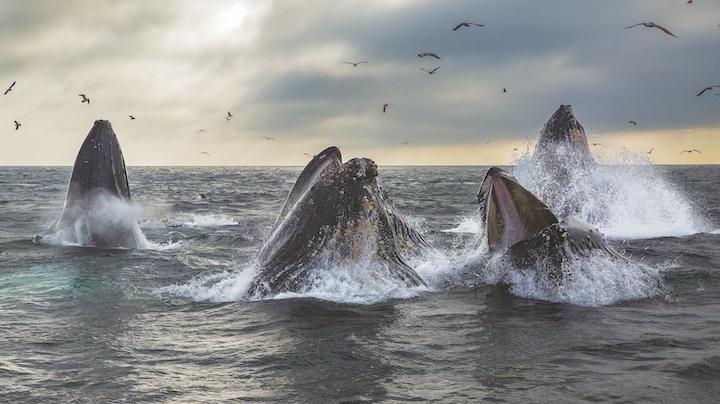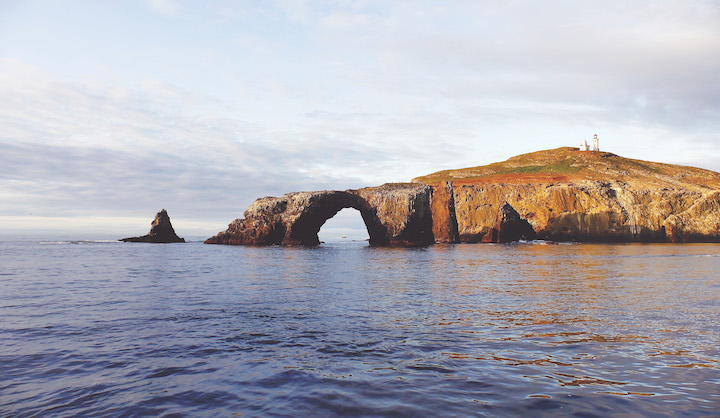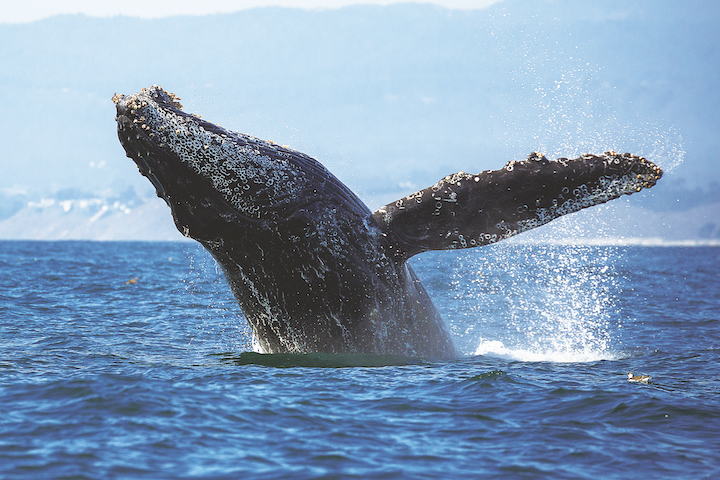Giant kelp forests are sometimes called the underwater counterpart to the redwoods. But almost 5,000 feet deeper, another forest gently sways in the cold, dark currents.
Sunlight never reaches these depths, but if it did, it would illuminate towering pink corals, neon yellow sponges, orange anemones and animals yet to be discovered.
This deep-sea habitat lies within the Monterey Bay National Marine Sanctuary (MBNMS), which stretches from Marin to Cambria along the California coast. It runs nearly 13,000 feet deep and includes beaches, rocky shorelines, estuaries, kelp forests and landscapes never before seen.
This September, the sanctuary will mark its 30th anniversary, while the National Marine Sanctuary Act commemorates its 50th. The celebration includes a nationwide photo contest and the issuance of 15 USPS stamps at a ceremony in Santa Cruz on August 5.
Over the decades, MBNMS has provided inspiration, research and recreation to local communities and visitors from around the world.

Off the Hook
In the early 1980s, President Ronald Reagan’s secretary of the interior, James Watt, proposed bidding the entire continental coastline to oil companies. But the 1969 Santa Barbara oil spill had demonstrated the environmental risks of offshore drilling, and Santa Cruz County wanted no part in it.
Leon Panetta, who was serving as the Central Coast’s congressional representative, organized a meeting with Mendocino representative Don Clausen to convince Watt to exempt certain areas from the bidding. During the meeting, they displayed photographs of beautiful coastline.
“Watt got up and walked over to one of those photographs with this wry smile on his face and pointed to this area where the waves were crashing and said, ‘You know, this would be a perfect place for an offshore drilling rig,’” Panetta tells GT. “And I thought, ‘Oh man, this is going to be tougher than I thought.’”
Panetta drafted a drilling moratorium and attached it as an amendment to an appropriations bill, which fund government operations annually. Funding would not be available to the administration if it proceeded with bidding.
“It was not easy,” Panetta says. “We were facing opposition, obviously, from oil states.”
But a delegation of coastal states came together to support the moratorium, which passed in the House and Senate. Still, it was no permanent solution.
“I was worried that if we faced a gas situation like we’re facing now, where there’s gas shortages and people are paying high prices, that ultimately the moratorium was likely to be defeated,” says Panetta.
He knew a marine sanctuary would provide longer-term protection. In 1992, Panetta and cosponsors made it a reality.
“We could make a unique case that this was an area that requires special protection, and so that’s what led to the bill being included in the sanctuary reauthorization,” says Panetta. “It’s always been one of my proudest achievements as a congressman, working with the community and being able to look out at that coastline and know that it is protected.”

Serengeti of the Sea
“When you look at the shape of the sanctuary, you can see that it really protects the Monterey Bay Canyon,” says Lisa Wooninck, the MBNMS Superintendent.
The Monterey Canyon is the largest of its kind along the West Coast. It begins at Moss Landing and extends out onto the abyssal plain two-and-a-half miles below the sea surface.
In the spring and summer, offshore winds push warm water away from the coast, and cold, nutrient-rich water rises from the deep. This process, called upwelling, supports life in the bay.
“That’s the engine for the amazing productivity that we have in this area,” says Wooninck. The whales, the birds, the fish and turtles—“we often call it the Serengeti of the sea because of the amount of wildlife that comes through to enjoy the amazing food,” she says.
In addition to preventing offshore drilling, the sanctuary prohibits harmful discharges and the disturbance of wildlife.
These protections make it an ideal location for studying marine life.
“The Monterey Bay is the best place to do marine science in the whole world,” says Andrew DeVogelaere, who oversees the sanctuary’s research program and has worked within MBNMS for 27 years. “We have the highest density of marine science institutes, and we have an amazing intellectual capability.”
DeVogelaere watched the sanctuary change over the years. Technological advances made exploration easier, collaborations grew stronger and habitats and marine life rebounded. But the problems changed, as well. Climate change and microplastic pollution threaten the sanctuary in new ways. And to better protect the oceans, we need to learn more about them.
“We’re impacting the deep sea before we even know how it functions,” says DeVogelaere.
As we spoke, he was preparing to board a Monterey Bay Aquarium Research Institute (MBARI) ship to visit Davidson Seamount. The undersea mountain was added to the sanctuary in 2008 because of its remarkable deep-sea corals. One of the most striking types, called bubblegum coral, often stretches over eight feet tall.
But another phenomenon also draws researchers back. In 2018, scientists from the sanctuary and the Ocean Exploration Trust discovered over a thousand octopus mothers brooding eggs on the seamount.
“We protected Davidson Seamount and added it to the sanctuary in 2008 mostly for the deep-sea corals, and it turns out there’s also this other interesting and important habitat,” says DeVogelaere. “So you don’t always know what you’re protecting when you protect an area of the seafloor.”
The Deep End
Future discoveries remain hidden in the depths of MBNMS.
“We’ve mapped it all, but we haven’t gone down with the remotely operated vehicle and actually explored very much of it. I’d say probably less than 10%,” estimates George Matsumoto, senior education and research specialist at MBARI.
“Anytime we go to a new location, we usually find something new,” he says. “It’s remarkable just how biodiverse the canyon is.”
MBARI works closely with sanctuary scientists and uses technology like underwater robots, deep-sea microphones and environmental DNA collection to learn about life in MBNMS.
“We’re fortunate to be working with a sanctuary that is so interested and concerned about the marine ecosystem,” says Matsumoto. “They’re very engaged in research and outreach.”
The sanctuary has a resource protection team, a research team and an outreach and education team. But with only 12 full-time staff members, 12 contractors and a handful of summer interns, they rely on partnerships.
The current budget for managing all 15 national marine sanctuaries and two national monuments—a total area the size of Alaska—is $61 million. President Biden recently requested that Congress increase that amount to $87 million.
“Using that, we could invest more into research, raising stewardship and connecting others to the sanctuary,” says Wooninck.
MBNMS has two visitor centers—one in San Simeon and one in Santa Cruz. The Sanctuary Exploration Center in Santa Cruz closed in March of 2020 and just reopened in June.
“One of the things we’re focusing on moving forward is connecting with different audiences and trying to reach communities we didn’t traditionally reach,” says Wooninck. “It’s amazing when you find out how many kids who live just five or ten miles from the ocean have never been to the ocean.”
The sanctuary recently secured a $300,000 grant from California State Parks to connect students to the sanctuary.
“We have a four-year grant, and we’re going to be specifically working with Watsonville schools fourth and fifth-graders,” says Wooninck.
“We’re trying to reach more underrepresented communities, indigenous communities adjacent to the sanctuary—not just our sanctuary, but all sanctuaries—and are really trying to expand our reach and help people to connect more with the ocean.”














So glad to hear about your funding for outreach to students whose communities are often left out. Looking forward to updates your progress and impact.
Super cool, like Anne I am stoked about the outreach!
Many people do not know that the MBNMS boundary is the “mean high tide line” of the beaches of Santa Cruz County. Therefore, shorebirds, resting and feeding along the shore are also protected by Sanctuary policies. Unfortunately, dog owners allow their dogs to run off lease and chase feeding birds, which stresses the birds, many migrating, who need rest and continual feeding for their long journeys. I hope readers of your excellent article, who have dogs, will think twice about allowing Sanctuary birds the ability to feed and rest along the shore by keeping their dogs leashed.